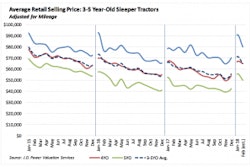
[This article was originally published in 2018 by Trucks, Parts, Service. It has been updated to include more timely information.]
Selling used trucks on a consignment basis can be a win-win for the truck dealer and the owner of the truck. The owner could get more for his vehicle through a consignment arrangement versus trade-in. The dealer gets practically free inventory — a truck on his sales lot that he didn’t have to obtain with a line of credit or buy outright.
But what is consignment? One example is an owner-operator brings his truck to a dealer and he and the dealer (consignor) discuss a selling price for the vehicle. The negotiation involves what the seller hopes to get and what the dealer, based on his experience, thinks the truck is worth. Other examples include fleets phasing out older trucks and OEM dealers looking to move trucks from other brands acquired through trades. Regardless of the scenario, the parties determine a value and discuss a set fee or percentage of the sale.
“You can hopefully make the truck bring the market price,” says Eddie Walker of Best Used Trucks in Rhome, Texas. “An individual will average 10 to 15 percent more for his piece of equipment by consigning it [compared with selling it wholesale],” he says.
Walker has about 65 trucks and trailers on his lot — half of his inventory is consignment trucks and the other half is inventory he’s purchased.
When a consignment customer drives into Best Used Trucks, Walker says he will assess the truck’s mechanical condition as well as what it will take to get it to “sparkle and shine.” A truck might require $1,500 in repairs and another $800 to recondition it to meet the high standards Walker has set for the trucks on his lot. If the owner agrees to those costs, Walker will scour all of his sources of past sales based on year, make and model, and present the owner with what he thinks the truck will sell for. Walker’s fee typically is 10 percent of the sale price, with a $2,000 minimum. “I want all the cards on the table [so the owner] understands what I feel the truck is going to bring,” he says.
If Walker gets an offer on a truck, he will call the owner to see if he wants to accept it. If the offer is below the asking price, the owner will still get a call about the offer, Walker says. If an offer lower than expected is accepted by the owner, the deal results in Walker getting less than his standard. “The way I look at it, it’s my responsibility to get you a cash offer,” he says, adding that given his intuition, experience and the homework he does in pricing a truck, this scenario rarely happens.
“[Consignment] is just a different way of marketing a product that helps people,” he says.
Customer service
“The No. 1 benefit certainly is free inventory” when selling trucks on consignment, says Mike Roney, wholesale manager of Used Truck City, which is an extension of the used truck department of Warner Truck Center, a Freightliner, Western Star and Sprinter dealer in Salt Lake City.
Used Truck City caters to Class 5-8 trucks. In addition to a 110 acre-plus facility, a large part of the business, which sells all major truck makes, is an expansive website in which inventory can be searched by manufacturer, year and price range.
In addition to free inventory, another reason to sell trucks on consignment is customer service, according to Roney.
“There are consignments where we will help customers sell [their truck] because we’re trying to get them into one of our trucks, but the payoff is bigger than what we’re willing to give them,” he says. “Let’s say the truck is worth $20,000 and he needs $25,000 to pay it off. The first best possible scenario is we’ll help him find a buyer for it.”
Used Truck City puts the truck on the lot and advertises it and posts it on the website, giving the owner’s truck the same exposure as the company’s own inventory. If someone is interested in the truck, the dealership will have the potential buyer call the owner. “At that point, [the consignment sale is] not so much a profit scenario; it’s a means to an end to have that customer be able to buy our truck,” Roney says.
With consignment trucks, it’s important to avoid “lot rot” —battery issues, leaks and other problems that can happen when trucks sit idle for too long, Roney says. That’s why he gives the truck 30 days to sell or else the owner has to take it off the lot. “We’re going to charge you a garage fee just to help the process of getting that truck off the lot,” he says. The 30-day proviso is part of an agreement the owner must sign.
The time limit might vary, but Roney encourages dealers to draw up agreements to protect themselves. Other than verifying a bank payoff with matching VIN or clean title showing the customer owns the truck, the agreement should state that the dealer doesn’t own the equipment and isn’t responsible for any loss, damage or upkeep. Furthermore, it should state the dealer is under no obligation to sell the truck.
Some dealerships don’t have well drawn up contracts, if they have agreements at all, Roney says. “I would suggest having a well-looked at consignment agreement that dealers’ lawyers say is protecting them as much as possible. That’s just good business,” he cautions.
Going once, going twice …
Another form of consignment different from selling trucks and equipment from a used truck dealer’s lot is selling them at auction.
Hess Auctioneers LLC does six auctions annually from its 18-acre site in Marietta, Pa. The company, which started in 2007, mostly sells consigned trucks and trailers, but their inventory also includes some construction and agricultural equipment. “We do about 800 catalogued items per auction,” says Bill Troop, general manager.
In addition to the owner-operator who wants to get the most for his vehicle, Troop says Hess gets inventory through relationships it has with fleets and banks that don’t have the resources or inclination to try to sell the vehicles themselves.
Dealers are another source of inventory. One reason is “to limit their aging inventory. We’ve had stuff come through that’s been sitting at a dealership for a year,” Troop says. Sometimes it’s because dealers don’t want to have a truck of a different brand on their lot or deal with a particular trade, he adds.
Regardless of who brings in a truck, if they want to put a reserve on a vehicle, the company helps guide them based on its past sales and other industry data. The two parties then enter into an agreement.
“Part of our agreement is if someone puts a reserve on something and it doesn’t meet that reserve, there is a no-sale fee that we can charge,” Troop says. “It’s a sliding scale based on the reserve amount, which runs from $100 to $350.”
If the owner wants to try to sell his truck at the next auction, Troop says they discuss adjusting or removing the reserve. If the vehicle is auctioned a third time, the owner would have to accept the highest bid. However, during all that time, Troop says it continues to advertise the vehicle in an effort to earn the owner a favorable sale price.
The consignor’s commission range is based on the value of the item, Troop says. For example, 6 percent of the sale price for a high-dollar item or 20 percent for equipment less than $1,000.
Perks Hess offers include a detailing center so owners can get their vehicles cleaned up and a technician to inspect trucks, which has proved helpful to Hess’ buyers online, where the company’s auctions have a much broader audience that could bring a seller higher bids if his truck is more in demand in a different location.
Hess started online bidding 13 years ago and for the last 10 or 11 years, on average “40 percent of what we sell is purchased by online bidders from all over the country,” Troop says.
Another auction company, Taylor & Martin, conducts live, no-reserve auctions from nine locations around the U.S. and will also bring the auction to a customer’s location based on volume and value of equipment being sold.
“Taking trucks to an auction is the easiest and most sensible way for many dealers to maximize their return on investment and keep a fresh inventory,” President Stacy Tracy says. “Most of our equipment comes from fleets or owner-operators that are selling as part of their regular replacement programs or in connection with fleet downsizing.”
Then there are trucks or trailers that need a national audience of prospective buyers because of a unique specification. Tracy adds that Taylor & Martin is one of Walmart’s biggest sellers of its used tractors.
The consignment process occurs between the seller and a regional Taylor & Martin sales representative. The representative provides market data and comparable pricing analysis to offer an expected auction value. The company charges a consignment fee percentage, depending on the value of the truck and, in the cases where multiple vehicles are being sold, the volume.
Vehicles are consigned with the understanding that Taylor & Martin is an absolute public auction, meaning all equipment will sell to the highest bidder. While the lack of reserve might seem risky for some sellers, “Our long history specific to the truck industry has made us the hallmark for auction services,” Tracy says.











